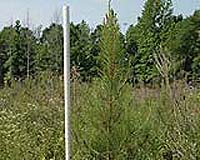| . |  |
. |
Houston TX (SPX) Jun 09, 2010 Global warming may present a threat to animal and plant life even in biodiversity hot spots once thought less likely to suffer from climate change, according to a new study from Rice University. Research by Amy Dunham, a Rice assistant professor of ecology and evolutionary biology, detailed for the first time a direct correlation between the frequency of El Nino and a threat to life in Madagascar, a tropical island that acts as a refuge for many unique species that exist nowhere else in the world. In this case, the lemur plays the role of the canary in the coal mine. The study in the journal Global Change Biology is currently available online and will be included in an upcoming print issue. Dunham said most studies of global warming focus on temperate zones. "We all know about the polar bears and their melting sea ice," she said. "But tropical regions are often thought of as refuges during past climate events, so they haven't been given as much attention until recently. "We're starting to realize that not only are these hot spots of biodiversity facing habitat degradation and other anthropogenic effects, but they're also being affected by the same changes we feel in the temperate zones." Dunham's interest in lemurs, which began as an undergraduate student at Connecticut College, resulted in a groundbreaking study last year that provided new insight into a long-standing mystery: Why male and female lemurs are the same size. This time, she set out to learn how El Nino patterns impact rainfall in southeastern Madagascar and how El Nino and cyclones affect the reproductive patterns of the Milne-Edwards' Sifaka lemur. The lemur's mating habits are well-defined, which makes the animal a good candidate for such a study. Female lemurs are sexually responsive to males for only one day a year in the austral summer months of December or January and give birth six months later. Dunham's co-authors - Elizabeth Erhart and Patricia Wright - have done behavioral studies of lemurs in Ranomafana, a national park in the southeastern rainforest of Madagascar, for 20 years. Erhart is an associate professor and assistant chair of the Department of Anthropology at Texas State University-San Marcos, and Wright is a professor of anthropology at Stony Brook University and director of the Institute for the Conservation of Tropical Environments. "There aren't many species that have such long-term demographic data that enable us to look at these kinds of questions," Dunham said. "So this was a unique opportunity." The warming of global sea temperatures may "enhance" El Nino cycles, according to the National Oceanic and Atmospheric Administration. Dunham found that in Ranomafana, contrary to expectations, El Nino makes wet seasons wetter. "When it rains heavily, lemurs are not active. They sit there and wait for the rain to stop, huddling for warmth," Dunham said. Anecdotal evidence suggested heavy rains knock fruit off the trees when lactating lemurs need it most, and may even kill trees outright. Dunham learned from the data that cyclones making landfall have a direct negative effect on the fecundity - or potential reproductive capacity - of lemurs. The team also discovered that fecundity "was negatively affected when El Nino occurred in the period before conception, perhaps altering ovulation, or during the second six months of life, possibly reducing infant survival during weaning," they wrote. "Madagascar's biodiversity is an ecological treasure," Dunham said. "But its flora and fauna already face extinction from rapid deforestation and exploitation of natural resources. The additional negative effects of climate change make conservation concerns even more urgent."
The research was funded by the David and Lucile Packard Foundation, the Douroucouli Foundation, the Wenner-Gren Foundation, the John D. and Catherine T. MacArthur Foundation, the National Geographic Society, the National Science Foundation, the Earthwatch Institute, Conservation International, the Margot Marsh Biodiversity Foundation, Stony Brook University and Rice University.
Read the abstract at: http://www3.interscience.wiley.com/journal/123301926/abstract
Share This Article With Planet Earth
Related Links Rice University Forestry News - Global and Local News, Science and Application
 Reforestation May Lower The Climate Change Mitigation Potential Of Forests
Reforestation May Lower The Climate Change Mitigation Potential Of ForestsNorman OK (SPX) Jun 03, 2010 Scientists at the University of Oklahoma and the Fudan University in Shanghai, China, have found that reforestation and afforestation - the creation of new forests - may lower the potential of forests for climate change lessening. Yiqi Luo, professor of ecology in the OU College of Arts and Sciences Department of Botany and Microbiology, and Changzhang Liao, Bo Li and Changming Fang, profe ... read more |
|
| The content herein, unless otherwise known to be public domain, are Copyright 1995-2010 - SpaceDaily. AFP and UPI Wire Stories are copyright Agence France-Presse and United Press International. ESA Portal Reports are copyright European Space Agency. All NASA sourced material is public domain. Additional copyrights may apply in whole or part to other bona fide parties. Advertising does not imply endorsement,agreement or approval of any opinions, statements or information provided by SpaceDaily on any Web page published or hosted by SpaceDaily. Privacy Statement |